Abstract
OBJECTIVES: This study sought to determine whether nutrient-rich whole grains reduce mortality risk. METHODS: The study included 38,740 Iowa women, aged 55 to 69 years. A food frequency questionnaire was used to obtain data on grain intake. RESULTS: Median whole grain intake quintiles ranged from a median of 0.2 to more than 3 servings per day. Women with higher intakes had healthier lifestyles and less baseline disease. The total death rate decreased in increasing quintiles, and the pattern repeated for cancer, cardiovascular disease, and other causes combined. Adjusted for lifestyle and baseline disease, the relative hazard rate ratio for total death was about 0.85 in daily consumers of whole grain. Findings persisted in strata of baseline healthy and diseased and were not explained by dietary fiber. Rates of total mortality, but not cardiovascular disease mortality, were higher among frequent consumers of refined grain. CONCLUSIONS: Total mortality risk was inversely associated with whole grain intake and positively associated with refined grain intake. Refined grains contributed more than 20% of energy intake, and whole grains contributed 1%. Substitution of whole for refined grain may reduce chronic disease risk in the United States.
Full text
PDF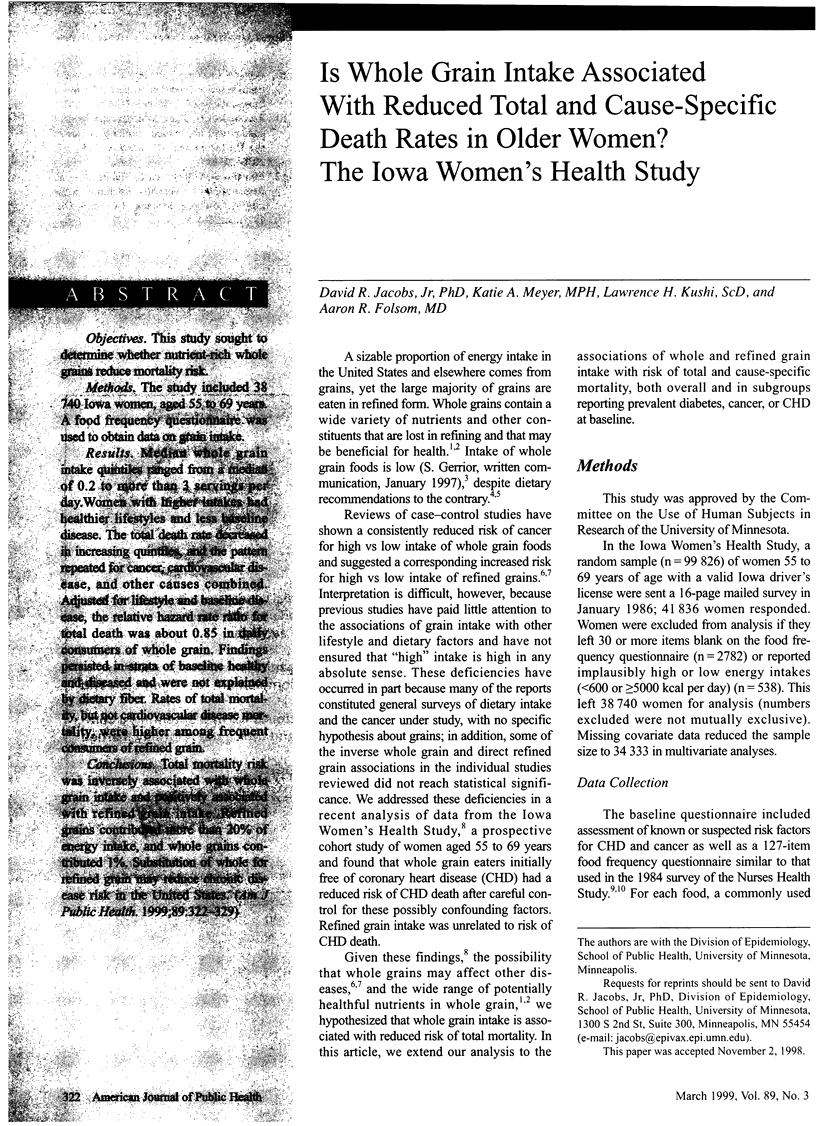
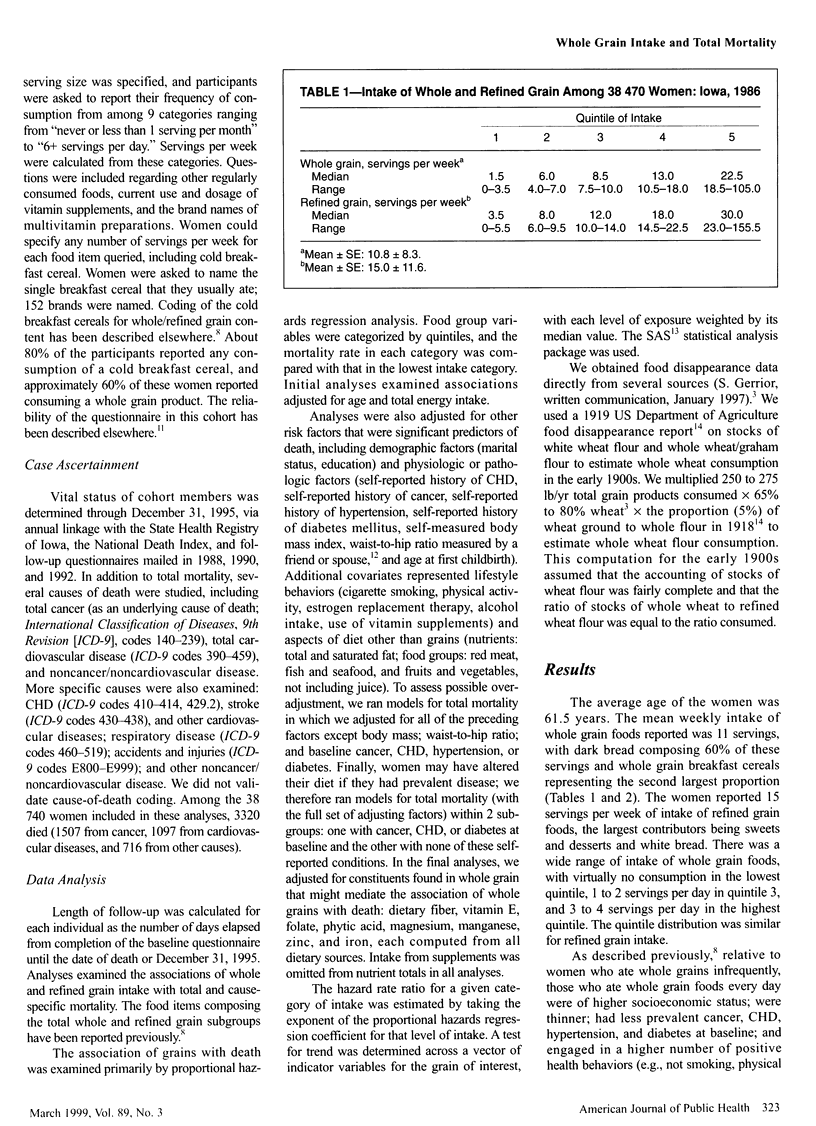

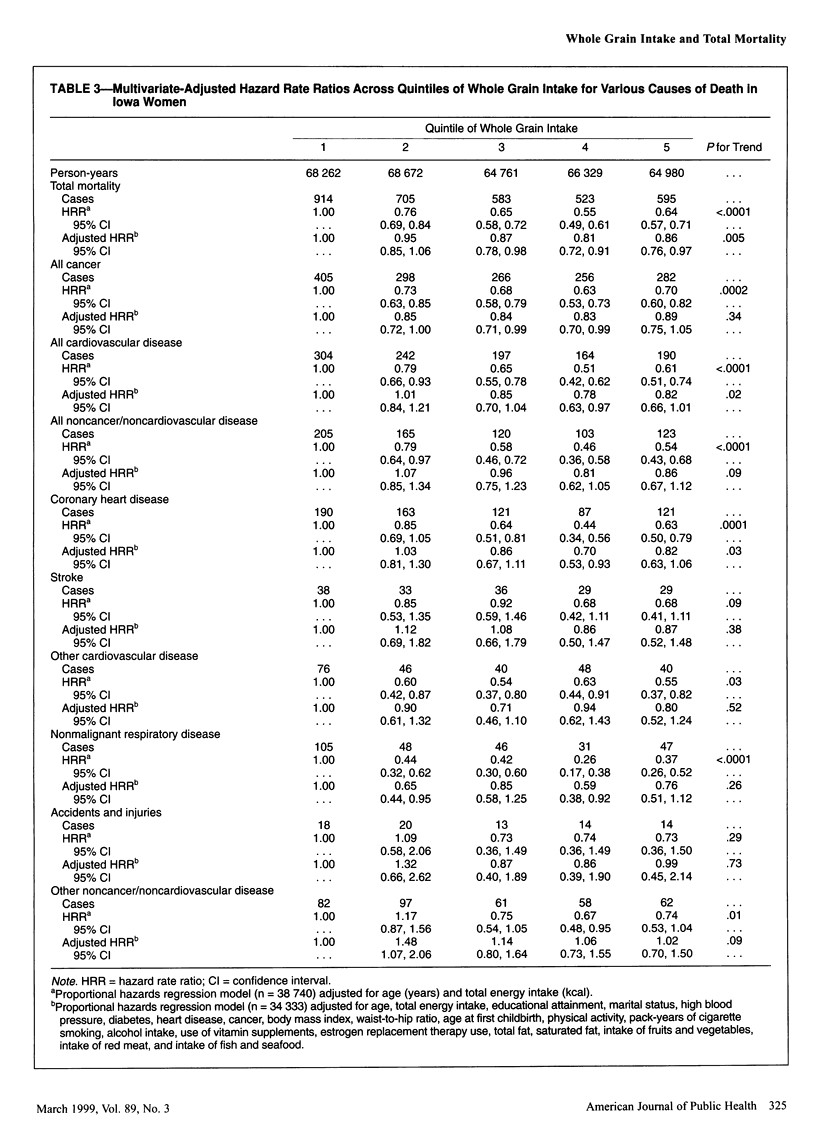
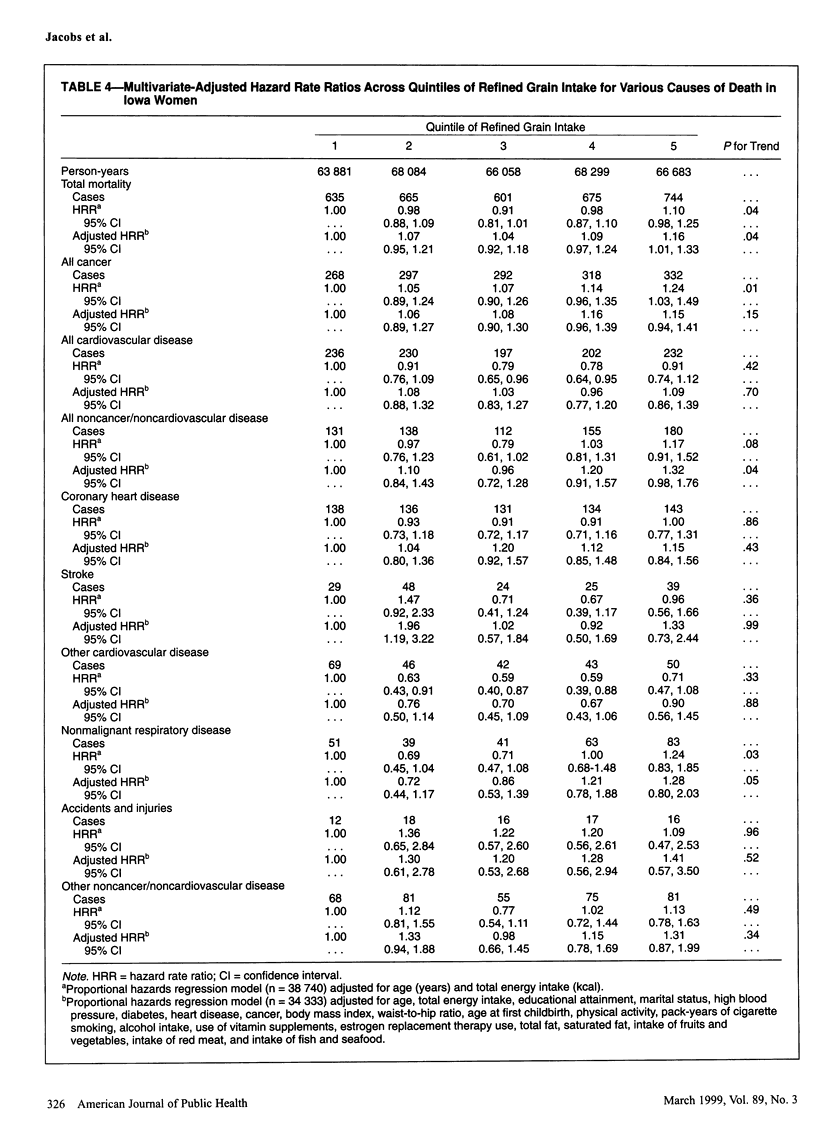

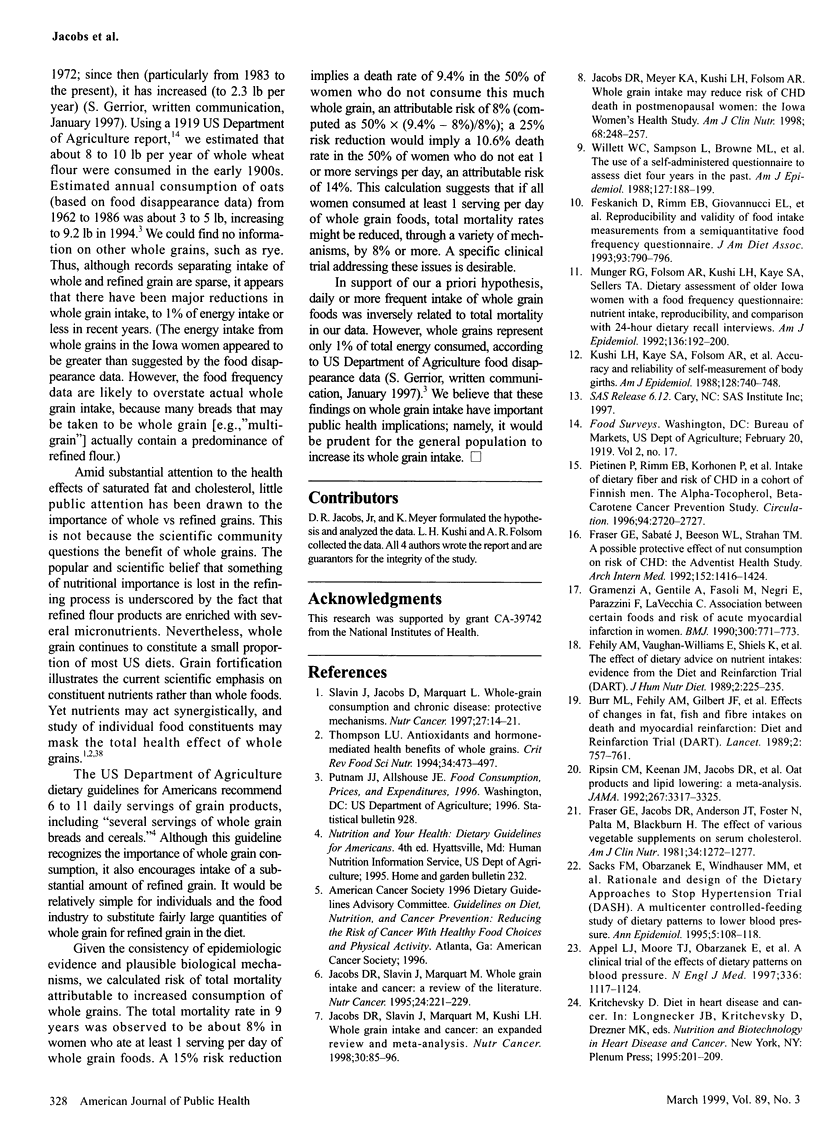
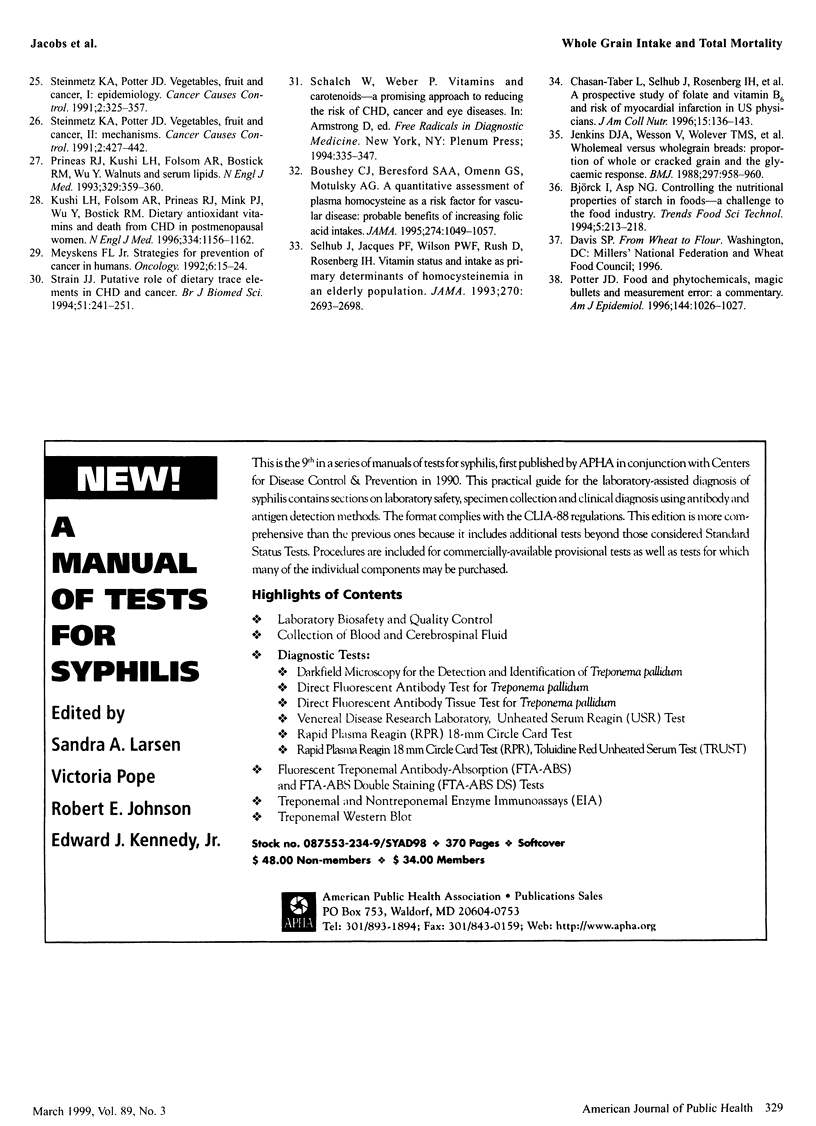
Selected References
These references are in PubMed. This may not be the complete list of references from this article.
- Appel L. J., Moore T. J., Obarzanek E., Vollmer W. M., Svetkey L. P., Sacks F. M., Bray G. A., Vogt T. M., Cutler J. A., Windhauser M. M. A clinical trial of the effects of dietary patterns on blood pressure. DASH Collaborative Research Group. N Engl J Med. 1997 Apr 17;336(16):1117–1124. doi: 10.1056/NEJM199704173361601. [DOI] [PubMed] [Google Scholar]
- Boushey C. J., Beresford S. A., Omenn G. S., Motulsky A. G. A quantitative assessment of plasma homocysteine as a risk factor for vascular disease. Probable benefits of increasing folic acid intakes. JAMA. 1995 Oct 4;274(13):1049–1057. doi: 10.1001/jama.1995.03530130055028. [DOI] [PubMed] [Google Scholar]
- Burr M. L., Fehily A. M., Gilbert J. F., Rogers S., Holliday R. M., Sweetnam P. M., Elwood P. C., Deadman N. M. Effects of changes in fat, fish, and fibre intakes on death and myocardial reinfarction: diet and reinfarction trial (DART). Lancet. 1989 Sep 30;2(8666):757–761. doi: 10.1016/s0140-6736(89)90828-3. [DOI] [PubMed] [Google Scholar]
- Chasan-Taber L., Selhub J., Rosenberg I. H., Malinow M. R., Terry P., Tishler P. V., Willett W., Hennekens C. H., Stampfer M. J. A prospective study of folate and vitamin B6 and risk of myocardial infarction in US physicians. J Am Coll Nutr. 1996 Apr;15(2):136–143. doi: 10.1080/07315724.1996.10718578. [DOI] [PubMed] [Google Scholar]
- Feskanich D., Rimm E. B., Giovannucci E. L., Colditz G. A., Stampfer M. J., Litin L. B., Willett W. C. Reproducibility and validity of food intake measurements from a semiquantitative food frequency questionnaire. J Am Diet Assoc. 1993 Jul;93(7):790–796. doi: 10.1016/0002-8223(93)91754-e. [DOI] [PubMed] [Google Scholar]
- Fraser G. E., Jacobs D. R., Jr, Anderson J. T., Foster N., Palta M., Blackburn H. The effect of various vegetable supplements on serum cholesterol. Am J Clin Nutr. 1981 Jul;34(7):1272–1277. doi: 10.1093/ajcn/34.7.1272. [DOI] [PubMed] [Google Scholar]
- Fraser G. E., Sabaté J., Beeson W. L., Strahan T. M. A possible protective effect of nut consumption on risk of coronary heart disease. The Adventist Health Study. Arch Intern Med. 1992 Jul;152(7):1416–1424. [PubMed] [Google Scholar]
- Gramenzi A., Gentile A., Fasoli M., Negri E., Parazzini F., La Vecchia C. Association between certain foods and risk of acute myocardial infarction in women. BMJ. 1990 Mar 24;300(6727):771–773. doi: 10.1136/bmj.300.6727.771. [DOI] [PMC free article] [PubMed] [Google Scholar]
- Jacobs D. R., Jr, Marquart L., Slavin J., Kushi L. H. Whole-grain intake and cancer: an expanded review and meta-analysis. Nutr Cancer. 1998;30(2):85–96. doi: 10.1080/01635589809514647. [DOI] [PubMed] [Google Scholar]
- Jacobs D. R., Jr, Meyer K. A., Kushi L. H., Folsom A. R. Whole-grain intake may reduce the risk of ischemic heart disease death in postmenopausal women: the Iowa Women's Health Study. Am J Clin Nutr. 1998 Aug;68(2):248–257. doi: 10.1093/ajcn/68.2.248. [DOI] [PubMed] [Google Scholar]
- Jacobs D. R., Jr, Slavin J., Marquart L. Whole grain intake and cancer: a review of the literature. Nutr Cancer. 1995;24(3):221–229. doi: 10.1080/01635589509514411. [DOI] [PubMed] [Google Scholar]
- Jenkins D. J., Wesson V., Wolever T. M., Jenkins A. L., Kalmusky J., Guidici S., Csima A., Josse R. G., Wong G. S. Wholemeal versus wholegrain breads: proportion of whole or cracked grain and the glycaemic response. BMJ. 1988 Oct 15;297(6654):958–960. doi: 10.1136/bmj.297.6654.958. [DOI] [PMC free article] [PubMed] [Google Scholar]
- Kushi L. H., Folsom A. R., Prineas R. J., Mink P. J., Wu Y., Bostick R. M. Dietary antioxidant vitamins and death from coronary heart disease in postmenopausal women. N Engl J Med. 1996 May 2;334(18):1156–1162. doi: 10.1056/NEJM199605023341803. [DOI] [PubMed] [Google Scholar]
- Kushi L. H., Kaye S. A., Folsom A. R., Soler J. T., Prineas R. J. Accuracy and reliability of self-measurement of body girths. Am J Epidemiol. 1988 Oct;128(4):740–748. doi: 10.1093/oxfordjournals.aje.a115027. [DOI] [PubMed] [Google Scholar]
- Meyskens F. L., Jr Strategies for prevention of cancer in humans. Oncology (Williston Park) 1992 Feb;6(2 Suppl):15–24. [PubMed] [Google Scholar]
- Munger R. G., Folsom A. R., Kushi L. H., Kaye S. A., Sellers T. A. Dietary assessment of older Iowa women with a food frequency questionnaire: nutrient intake, reproducibility, and comparison with 24-hour dietary recall interviews. Am J Epidemiol. 1992 Jul 15;136(2):192–200. doi: 10.1093/oxfordjournals.aje.a116485. [DOI] [PubMed] [Google Scholar]
- Pietinen P., Rimm E. B., Korhonen P., Hartman A. M., Willett W. C., Albanes D., Virtamo J. Intake of dietary fiber and risk of coronary heart disease in a cohort of Finnish men. The Alpha-Tocopherol, Beta-Carotene Cancer Prevention Study. Circulation. 1996 Dec 1;94(11):2720–2727. doi: 10.1161/01.cir.94.11.2720. [DOI] [PubMed] [Google Scholar]
- Potter J. D. Food and phytochemicals, magic bullets and measurement error: a commentary. Am J Epidemiol. 1996 Dec 1;144(11):1026–1027. doi: 10.1093/oxfordjournals.aje.a008873. [DOI] [PubMed] [Google Scholar]
- Prineas R. J., Kushi L. H., Folsom A. R., Bostick R. M., Wu Y. Walnuts and serum lipids. N Engl J Med. 1993 Jul 29;329(5):359–360. [PubMed] [Google Scholar]
- Ripsin C. M., Keenan J. M., Jacobs D. R., Jr, Elmer P. J., Welch R. R., Van Horn L., Liu K., Turnbull W. H., Thye F. W., Kestin M. Oat products and lipid lowering. A meta-analysis. JAMA. 1992 Jun 24;267(24):3317–3325. [PubMed] [Google Scholar]
- Sacks F. M., Obarzanek E., Windhauser M. M., Svetkey L. P., Vollmer W. M., McCullough M., Karanja N., Lin P. H., Steele P., Proschan M. A. Rationale and design of the Dietary Approaches to Stop Hypertension trial (DASH). A multicenter controlled-feeding study of dietary patterns to lower blood pressure. Ann Epidemiol. 1995 Mar;5(2):108–118. doi: 10.1016/1047-2797(94)00055-x. [DOI] [PubMed] [Google Scholar]
- Selhub J., Jacques P. F., Wilson P. W., Rush D., Rosenberg I. H. Vitamin status and intake as primary determinants of homocysteinemia in an elderly population. JAMA. 1993 Dec 8;270(22):2693–2698. doi: 10.1001/jama.1993.03510220049033. [DOI] [PubMed] [Google Scholar]
- Slavin J., Jacobs D., Marquart L. Whole-grain consumption and chronic disease: protective mechanisms. Nutr Cancer. 1997;27(1):14–21. doi: 10.1080/01635589709514495. [DOI] [PubMed] [Google Scholar]
- Steinmetz K. A., Potter J. D. Vegetables, fruit, and cancer. I. Epidemiology. Cancer Causes Control. 1991 Sep;2(5):325–357. doi: 10.1007/BF00051672. [DOI] [PubMed] [Google Scholar]
- Steinmetz K. A., Potter J. D. Vegetables, fruit, and cancer. II. Mechanisms. Cancer Causes Control. 1991 Nov;2(6):427–442. doi: 10.1007/BF00054304. [DOI] [PubMed] [Google Scholar]
- Strain J. J. Putative role of dietary trace elements in coronary heart disease and cancer. Br J Biomed Sci. 1994 Sep;51(3):241–251. [PubMed] [Google Scholar]
- Thompson L. U. Antioxidants and hormone-mediated health benefits of whole grains. Crit Rev Food Sci Nutr. 1994;34(5-6):473–497. doi: 10.1080/10408399409527676. [DOI] [PubMed] [Google Scholar]
- Willett W. C., Sampson L., Browne M. L., Stampfer M. J., Rosner B., Hennekens C. H., Speizer F. E. The use of a self-administered questionnaire to assess diet four years in the past. Am J Epidemiol. 1988 Jan;127(1):188–199. doi: 10.1093/oxfordjournals.aje.a114780. [DOI] [PubMed] [Google Scholar]


